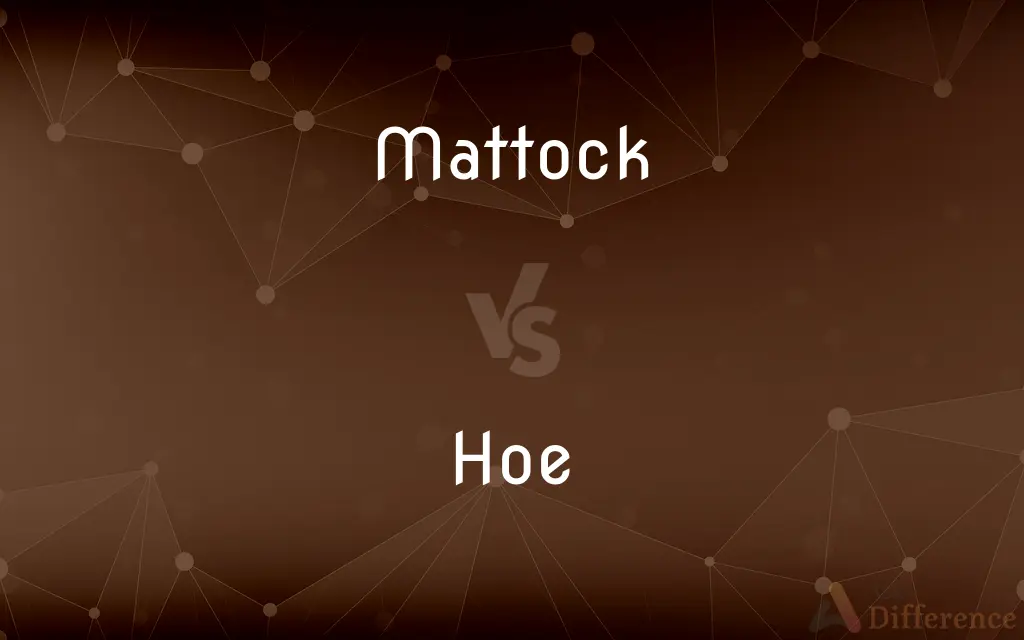Mattock vs. Hoe — What's the Difference?
By Fiza Rafique & Urooj Arif — Updated on April 1, 2024
A mattock is a versatile digging and chopping tool, ideal for breaking up hard soil or rock, while a hoe is designed for shaping soil, removing weeds, and harvesting root crops.

Difference Between Mattock and Hoe
Table of Contents
ADVERTISEMENT
Key Differences
Mattocks are heavy-duty, dual-purpose tools with a head that combines an adze and a pick or axe, making them suitable for tough landscaping tasks, such as breaking up rocky or clay soils and uprooting tree stumps. They are known for their strength and ability to handle rough terrains. On the other hand, hoes have a long, straight handle and a thin, flat blade, used mainly for agricultural purposes like weeding, hilling, and creating furrows for planting seeds. Hoes are lighter than mattocks and are designed for precision work in gardens and farms.
While mattocks are often used for heavy-duty tasks in landscaping and excavation, requiring a swinging motion to effectively break up materials, hoes are utilized in a pushing or pulling motion to cut weeds, loosen soil, or move and shape soil. This distinction makes each tool particularly suited to specific types of work; mattocks for labor-intensive ground breaking and hoes for more delicate, surface-level soil manipulation.
The construction of a mattock is robust, with a head made from heavy metal to withstand the force needed to break apart hard materials. In contrast, the hoe's head is typically lighter and sharper, designed for slicing through the soil and cutting plants near the surface without requiring significant force.
Considering the operational technique, mattocks require a user to exert a considerable amount of energy in a vertical chopping motion, making them less suitable for prolonged use by individuals seeking a less strenuous tool. Conversely, hoes, with their horizontal soil manipulation method, are more user-friendly for extended periods of gardening or farming, offering a less physically demanding experience.
Mattocks are essential tools for preparing new or unworked land for gardening or construction, capable of tackling soil that is too hard or rocky for other tools. Hoes, however, excel in the maintenance and cultivation of existing gardens and farms, where the soil is already loose, and the primary tasks involve weed control, soil aeration, and planting.
ADVERTISEMENT
Comparison Chart
Primary Use
Breaking up hard or rocky soil, excavation
Weeding, soil shaping, planting
Head Design
Adze and pick/axe
Thin, flat blade
Weight
Heavy, for tough tasks
Lighter, for precision work
Motion
Swinging to chop or dig
Pushing or pulling to cut or move soil
Best For
Tough landscaping, breaking new ground
Garden maintenance, weeding, planting
Compare with Definitions
Mattock
Dual-Purpose Tool.
The mattock's adze side is great for digging, while its axe side chops through roots.
Hoe
Agricultural Tool.
The hoe is essential for weeding and creating furrows for seeds.
Mattock
Heavy-Duty Construction.
With its robust metal head, the mattock can easily break up rocky soil.
Hoe
User-Friendly.
The hoe's design allows for easy use over extended periods without much fatigue.
Mattock
Versatile in Landscaping.
Landscapers use mattocks to clear land and prepare new garden beds.
Hoe
Light and Sharp.
The hoe's sharp blade makes it perfect for cutting through soil and roots.
Mattock
Ideal for Rough Terrains.
The mattock is indispensable for working in areas with dense soil or clay.
Hoe
Precision Work.
Gardeners use hoes for precise tasks like hilling plants and harvesting root vegetables.
Mattock
Requires Strength to Use.
Using a mattock requires physical strength to swing and break ground.
Hoe
Garden Maintenance.
Regular use of a hoe in the garden helps keep weeds under control and soil aerated.
Mattock
A mattock is a hand tool used for digging, prying, and chopping. Similar to the pickaxe, it has a long handle and a stout head which combines either a vertical axe blade with a horizontal adze (cutter mattock), or a pick and an adze (pick mattock).
Hoe
A tool with a flat blade attached approximately at a right angle to a long handle, used for weeding, cultivating, and gardening.
Mattock
A digging tool with a flat blade set at right angles to the handle.
Hoe
To weed, cultivate, or dig up with a hoe.
Mattock
An agricultural tool whose blades are at right angles to the body, similar to a pickaxe.
Hoe
To work with a hoe.
Mattock
To cut or dig with a mattock.
Hoe
An agricultural tool consisting of a long handle with a flat blade fixed perpendicular to it at the end, used for digging rows.
Mattock
An implement for digging and grubbing. The head has two long steel blades, one like an adz and the other like a narrow ax or the point of a pickax.
'T is you must dig with mattock and with spade.
Hoe
Alternative spelling of ho.
Mattock
A kind of pick that is used for digging; has a flat baled set at right angles to the handle
Hoe
A piece of land that juts out towards the sea; a promontory.
Hoe
(ambitransitive) To cut, dig, scrape, turn, arrange, or clean, with this tool.
To hoe the earth in a garden
Every year, I hoe my garden for aeration.
I always take a shower after I hoe in my garden.
Hoe
(transitive) To clear from weeds, or to loosen or arrange the earth about, with a hoe.
To hoe corn
Hoe
Alternative spelling of ho.
Hoe
A tool chiefly for digging up weeds, and arranging the earth about plants in fields and gardens. It is made of a flat blade of iron or steel having an eye or tang by which it is attached to a wooden handle at an acute angle.
Hoe
The horned or piked dogfish. See Dogfish.
Hoe
To cut, dig, scrape, turn, arrange, or clean, with a hoe; as, to hoe the earth in a garden; also, to clear from weeds, or to loosen or arrange the earth about, with a hoe; as, to hoe corn.
Hoe
To use a hoe; to labor with a hoe.
Hoe
A tool with a flat blade attached at right angles to a long handle
Hoe
Dig with a hoe;
He is hoeing the flower beds
Common Curiosities
What is a mattock used for?
A mattock is used for breaking up hard or rocky soil and excavation tasks.
What type of motion is required to operate a mattock effectively?
A vertical chopping motion is needed to use a mattock effectively.
Can a mattock be used for gardening?
Yes, mattocks can be used for gardening, especially for preparing new beds or in areas with tough soil.
Is a hoe suitable for heavy-duty tasks?
No, hoes are better suited for lighter tasks like weeding, shaping soil, and planting.
What is the best tool for preparing new land for gardening?
A mattock is best for preparing new or unworked land due to its ability to break up hard and rocky soil.
How does a hoe differ from a mattock in terms of design?
A hoe has a long, straight handle with a thin, flat blade, whereas a mattock has a more robust head that combines an adze and a pick or axe.
Can a hoe break up rocky soil?
Hoes are not ideal for breaking up rocky soil; that's a job better suited for a mattock.
How does the weight of a hoe affect its use?
The lighter weight of a hoe makes it easier to handle for precision tasks and reduces user fatigue.
What makes a hoe user-friendly?
The hoe's lightweight design and ease of use in a pushing or pulling motion make it user-friendly.
How do you maintain a mattock?
Keep it clean, sharpen its edges regularly, and store it in a dry place to prevent rust.
Are mattocks difficult to use?
Mattocks require more strength and energy to use due to their heavy construction and the swinging motion needed.
Why might someone choose a hoe over a mattock for garden work?
A hoe is lighter and designed for precision work, making it more suitable for tasks like weeding and planting.
Is a mattock necessary for every garden?
Not necessarily; it depends on the soil condition and the type of work needed. Mattocks are more essential for tough terrains.
Can you use a mattock for weeding?
While possible, it's not recommended due to its heavy construction and the damage it can do to the soil structure.
Why is a hoe considered essential for agricultural work?
Its design makes it ideal for weeding, soil shaping, and preparing land for planting, essential tasks in agriculture.
Share Your Discovery

Previous Comparison
Convulsion vs. Tremor
Next Comparison
Judea vs. JudahAuthor Spotlight
Written by
Fiza RafiqueFiza Rafique is a skilled content writer at AskDifference.com, where she meticulously refines and enhances written pieces. Drawing from her vast editorial expertise, Fiza ensures clarity, accuracy, and precision in every article. Passionate about language, she continually seeks to elevate the quality of content for readers worldwide.
Co-written by
Urooj ArifUrooj is a skilled content writer at Ask Difference, known for her exceptional ability to simplify complex topics into engaging and informative content. With a passion for research and a flair for clear, concise writing, she consistently delivers articles that resonate with our diverse audience.













































